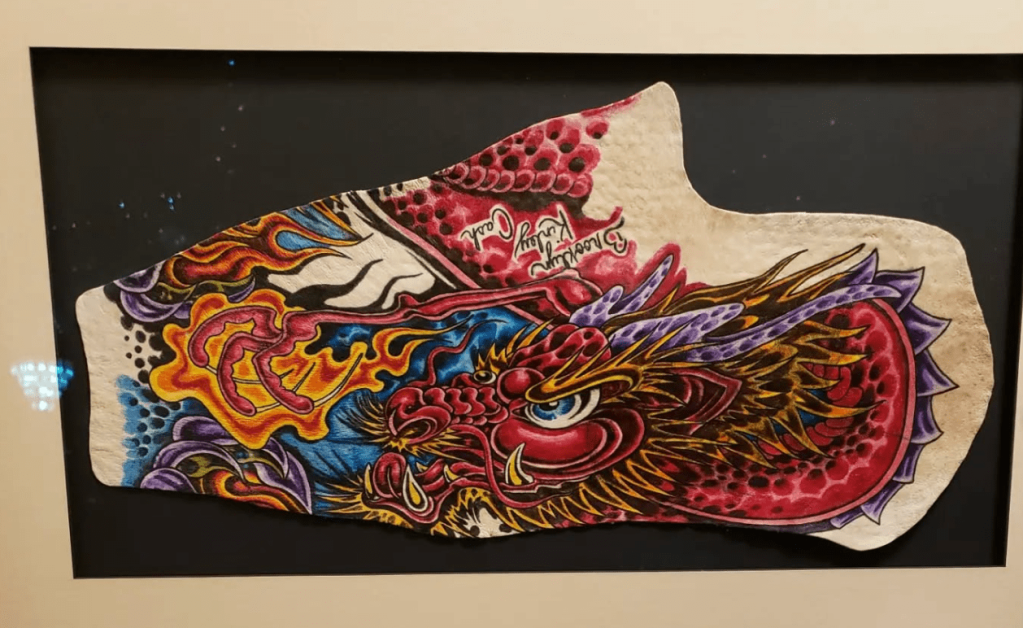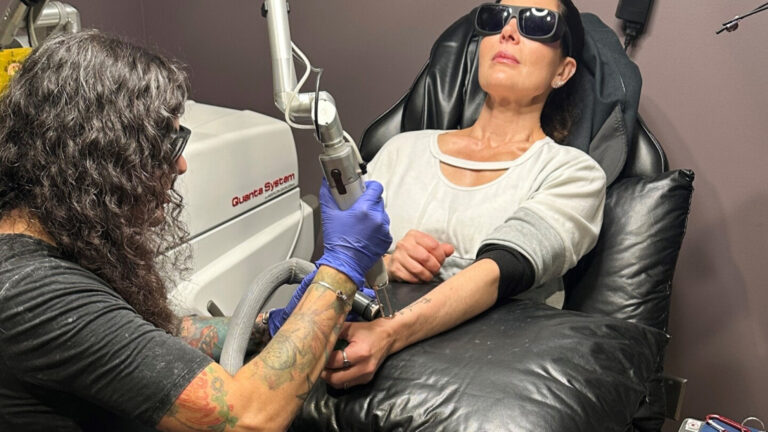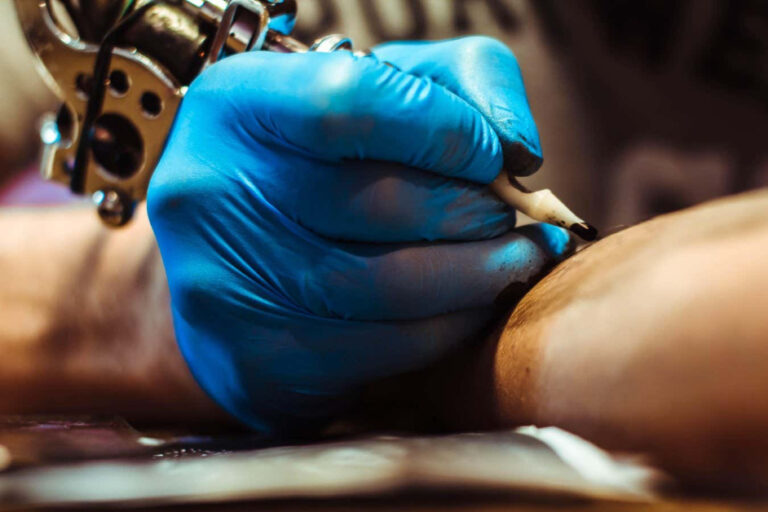Get the Popular Science daily newsletter💡
Breakthroughs, discoveries, and DIY tips sent every weekday.
Tattoos, as anyone’s concerned parents have reminded them, are notoriously permanent. But even ink needled under the surface of the skin can’t withstand time’s inescapable weathering. Untreated dead bodies eventually decay, and skin dotted with panels of stark-lined tigers or delicate wildflowers eventually break down to nothing more than the soil around it.
A father and son team of morticians are trying to break that natural cycle using a secretive formula, preservative chemicals, and a taxidermist’s eye.
The duo operates the Ohio-based company Save My Ink Forever, which removes a corpse’s tattooed skin, treats it, and then returns the tattooed skin to the deceased’s loved ones. The end product, which looks closer to aged parchment paper than a Cronenberg-style horror trinket, currently hangs behind framed, museum-quality glass in the homes of thousands of customers.
And while many, including some funeral homes responsible for removing the skin, might turn their noses up at the practice, founder Kyle Sherwood told Popular Science that he sees preserving tattooed flesh as no more off-putting than keeping a relative’s ashes in an urn. For customers, the framed skins serve as a visual reminder of the people they’ve lost and the physical art that came to define their identity. Sherwood, who has always had an artistic disposition but prioritized financial practicality, says preserving tattooed skin with dignity and respect for families has become his passion.
“Embalming became my art form,” Sherwood said.
Sherwood founded Save My Ink Forever in 2017 with his father, Michael. Since then, the pair estimate they’ve preserved thousands of tattoos. Kyle says he came up with the concept while working at funeral homes and seeing families demand an increasing level of personalized options for the deceased. That trend coincided with a boom in tattoo adoption and acceptance. In 2023, Pew Research estimated nearly a third of US adults and 46 percent of millennials have at least one tattoo.
It took some persuading, but Kyle says he convinced his father of an untapped market bridging the gap between tattoo collectors and funeral home services. But he also had to prove that his tattoo preservation process would actually work. Rather than starting with skin from the deceased, Sherwood says they conducted early tests using excess skin from tummy tuck surgeries. Volunteers willingly tattooed themselves before the procedure, agreeing to donate their removed skin afterwards for testing. It worked.
Today, nearly a decade later, Save My Ink is still the only major company offering the service. Legally, Sherwood says they are able to operate in every state except Washington. They’ve also worked with funeral homes in the United Kingdom and Canada.
How the tattoo preservation process works
The process for requesting tattoo flesh preservation can begin before death or up to 72 hours after someone’s death. The person making the request—often the tattooed individual’s partner or next of kin—works with a local funeral home, which acts as a kind of middle-man between the family and Save My Ink. After signing an authorization form, the Sherwoods send the funeral home an instructional video with a step-by-step guide on how to properly extract the skin and store it for preservation. Most of the people asking for tattoos tend to ask for individual tattoos (which costs $1,699), though the company will do entire arms and legs sleeves and even body suits—a pricey endeavor that can cost $100,000. Tattoos located on the tops of hands and feet tend to preserve the best, Sherwood added.
[Related: Where does tattoo ink go in your body? There’s one particular spot.]
The funeral home then ships the skin to Save My Ink in a dry preservative (Sherwood notes that the exact chemical formula is a trade secret), and it typically arrives within a few days. Save My Ink delivers the final product, encased in glass, to the family, usually within three months.
Sherwood says they’ve had to set some boundaries in recent years. Save My Ink won’t preserve genital or facial tattoos. They also refuse requests to turn skin into lampshades or other trinkets—something people have asked about in the past. But that doesn’t mean they’re unwilling to consider all unusual requests. Sherwood told Popular Science that they have preserved tattoos from living people who lost significant amounts of weight, as well as those who underwent gender reassignment surgery. They’re also happy to preserve tattoos from amputated limbs as well as certain meaningful scars.
Adapt or die
Of course, the business isn’t without its detractors. Many people still recoil at the idea of hanging grandpa’s preserved flesh on the wall. Some funeral homes—particularly those with more traditional religious values—also aren’t on board and have refused to extract the skin, Sherwood said. While he acknowledges that the process isn’t for everyone, Sherwood still believes funeral homes should be willing to honor a family’s wishes.
“Most funeral homes and people in it are stuck in their ways,” Sherwood said. Ensuring business success moving forward, he added, means being willing to “adapt or die.”
From museum to private collections: the odd history of saving tattooed skin
Save My Ink might not have much company in the commercial tattoo preservation space, but the practice itself isn’t new. A handful of museums around the world, like the Muséum National d’Histoire Naturelle in France and the Instituto Nacional de Medicina Legal e Ciências Forenses in Portugal, maintain collections of tattooed skin. In these cases, the skin was preserved less for the artistic value and more as medical or anthropological specimens. The Wellcome Collection at London’s Science Museum is considered the largest repository of preserved tattooed skin, with over 300 individual fragments. That collection, which has faced some criticism regarding the historical ethical sourcing of its specimens, includes tattooed skin from arms, legs, and even entire skulls.
[Related: Inside the warehouse that builds machines to liquify dead bodies]
The Wellcome Collection did not respond to Popular Science’s request for comment.

Another large collection of tattooed skin resides in the Medical Pathology Museum at the University of Tokyo. Primarily extracted from deceased yakuza members, the skins were first collected by Japanese medical doctor Masaichi Fukushi. As detailed in the 2013 book Wear Your Dreams: My Life in Tattoos, Fukushi began the collection while studying the effects of syphilis on human skin. He reportedly sought out tattooed specimens because the color and texture variations made it easier to track pigment movement. During his research though, Fukushi discovered that tattooed skin appeared to resist the damage and lesions typically associated with syphilis, particularly in areas with prominent ink. Some of his preserved skins were even featured in a 1950s edition of Life magazine.
When asked about the museum’s collections, Sherwood said he was considering taking on his own curatorial role but with an emphasis on showcasing the artistry behind tattoos. He envisioned a future in which customers who preserved tattooed skin could agree to loan it for display on a limited time basis. Sherwood compared some tattoo artists to “modern-day van Goghs and Rembrandts.” But unlike their oil-painting forebears, tattoo artists’ creations die alongside them, their only traces scattered across photographs or old social media posts.
Fittingly, Sherwood has already chosen one of his own tattoos to preserve. On one of his legs are images of three “trocars”—medicinal instruments shaped like large pencils that are a staple in a mortician’s toolbox. The three represent the generations of morticians from which Sherwood descends. One day, that preserved skin might even appear behind glass in Sherwood’s future collection for the world to see.

More deals, reviews, and buying guides
The PopSci team has tested hundreds of products and spent thousands of hours trying to find the best gear and gadgets you can buy.



